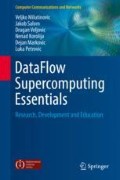Abstract
This chapter analyzes potentials of accelerating applications by transforming them from control flow to dataflow representation and mapping them directly to the hardware based on the FPGA. Firstly, potentials for improvements will be analyzed. Both reduction in execution time and power consumption will be analyzed. Transforming control flow to dataflow applications will be analyzed on a Huxley muscle model implemented using the dataflow approach.
Access this chapter
Tax calculation will be finalised at checkout
Purchases are for personal use only
References
A. Kos, S. Tomažič, J. Salom, N. Trifunovic, M. Valero, and V. Milutinovic, “New Benchmarking Methodology and Programming Model for Big Data Processing,” International Journal of Distributed Sensor Networks, vol. 2015, Article ID 271752, pp. 1–7.
M. Flynn, O. Mencer, V., Milutinovic, G., Rakocevic, P., Stenstrom, M., Valero, and R., Trobec, “Moving from PetaFlops to PetaData,” Communications of the ACM, May 2013, pp. 39–43.
N. Trifunovic, V. Milutinovic, J. Salom, and A. Kos, “Paradigm Shift in Big Data SuperComputing: DataFlow vs. ControlFlow,” Journal of Big Data, 2015.
Blagojevic, et al, “A Systematic Approach to Generation of New Ideas for PhD Research in Computing,” Advances in Computers, Vol. 102, 2015.
A. Hurson and V. Milutinovic, “Special Issue on DataFlow SuperComputing,” Advances in Computers, Vol. 96, 2015.
V. Milutinovic, J. Salom, N. Trifunovic, and R. Giorgi, “Guide to DataFlow Supercomputing,” Springer International Publishing, 2015, pp. 1–129.
V. Milutinovic and A. Hurson, “Dataflow Processing,” Academic Press, 1st edition, 2015, pp. 1–266.
R. P. Feynman, “Lectures on Computation,” The ACM Digital Library, 1998.
T. Nowatzki, V. Gangadhar, and K. Sankaralingam, “Exploring the potential of heterogeneous von neumann/dataflow execution models,” Proceedings of the 42nd Annual International Symposium on Computer Architecture, June 13, 2015, ACM, pp. 298–310.
S. Stojanovic, D. Bojic, and M. Bojovic, “An Overview of Selected Heterogeneous and Reconfigurable Architectures,” Advances in Computers, Vol. 96, Burlington: Academic Press, 2015, pp. 1–45.
N. Korolija, T. Djukic, V. Milutinovic, and N. Filipovic, “Accelerating Lattice-Boltzman Method Using the Maxeler DataFlow Approach,” Transactions on Internet Research, Vol. 9, No. 2, July 2013, pp. 5–10.
S. Stojanovic, D. Bojic, and V. Milutinovic, “Solving Gross Pitaevskii Equation Using Dataflow Paradigm,” Transactions on Internet Research, Vol. 9, No. 2, July 2013.
A. Kos, V. Rankovic, and S. Tomazic, “Sorting networks on Maxeler dataflow supercomputing systems,” Advances in computers, Vol. 96. Amsterdam, Elsevier: Academic Press, cop, 2015, pp. 139–186.
V. Rankovic, A. Kos, and V. Milutinovic, “Bitonic Merge Sort Implementation on the Maxeler Dataflow Supercomputing System,” Transactions on Internet Research, Vol. 9, No. 2, July 2013, pp. 34–42.
J. Gustafson, “Reevaluating Amdahl’s law,” Communications of the ACM 31.5 (1988): 532–533.
O. Pell, J. Bower, R. Dimond, O. Mencer, and M. J. Flynn “Finite Difference Wave Propagation Modeling on Special Purpose Dataflow Machines,” IEEE Transactions on Parallel and Distributed Systems, 2012, doi: 10.1109/TPDS.2012.198.
P. Marchetti, D. Oriato, O. Pell, A.M. Cristini, and D. Theis, “Fast 3D ZO CRS Stack,” 72nd European Association of Geoscientists and Engineers (EAGE) Conference, June 2010.
O. Lindtjorn, R. G. Clapp, O. Pell, O. Mencer, and M. J. Flynn, “Surviving the End of Scaling of Traditional Microprocessors in HPC,” IEEE HOT CHIPS 22, Stanford, USA, August 2010.
http://appgallery.maxeler.com/, web site visited on March 17, 2017.
N. Trifunovic, V. Milutinovic, et al, “The Appgallery.Maxeler.com for BigData SuperComputing,” Journal of Big Data, Springer, 2016.
N. Korolija, J. Popovi, M. Cvetanovi, and M. Bojovi, “Dataflow Based Parallelization of Control-Flow Algorithms,” Creativity in Computing and Dataflow Supercomputing, Advances in Computers, Vol. 104, 2017.
S. Stojanovic et al., “Coupling finite element and huxley models in multiscale muscle modeling,” Bioinformatics and Bioengineering (BIBE), 2015 IEEE 15th International Conference on. IEEE, 2015.
M. Ivanovi et al., “Distributed multi-scale muscle simulation in a hybrid MPICUDA computational environment,” Simulation 92.1 (2016): 19–31.
A. Kaplarevi-Malii, et al., “Employing phenomenological model in load-balancing optimization of parallel multi-scale muscle simulations,” Bioinformatics and Bioengineering (BIBE), 2015 IEEE 15th International Conference on. IEEE, 2015.
https://github.com/oandric/Huxley-Muscle-Model/tree/master/APP/EngineCode/src/huxleymusclemodel, web site visited on March 5, 2017.
https://github.com/oandric/Huxley-Muscle-Model/blob/master/APP/CPUCode/HuxleyMuscleModelCpuCode.c, web site visited on March 5, 2017.
https://github.com/oandric/Huxley-Muscle-Model/blob/master/APP/EngineCode/src/huxleymusclemodel/HuxleyMuscleModelKernel.maxj, web site visited on March 5, 2017.
Blagojevic, V., et al, “A Systematic Approach to Generation of New Ideas for PhD Research in Computing,” Advances in Computers, Elsevier, Vol. 104, 2016, pp. 1–19.
Acknowledgements
This research was supported by School of Electrical Engineering, Ministry of Education, Science, and Technological Development of the Republic of Serbia [TR32047] and Maxeler Technologies, Belgrade, Serbia.
Author information
Authors and Affiliations
Rights and permissions
Copyright information
© 2017 Springer International Publishing AG
About this chapter
Cite this chapter
Milutinovic, V., Salom, J., Veljovic, D., Korolija, N., Markovic, D., Petrovic, L. (2017). Transforming Applications from the Control Flow to the Dataflow Paradigm. In: DataFlow Supercomputing Essentials. Computer Communications and Networks. Springer, Cham. https://doi.org/10.1007/978-3-319-66128-5_4
Download citation
DOI: https://doi.org/10.1007/978-3-319-66128-5_4
Published:
Publisher Name: Springer, Cham
Print ISBN: 978-3-319-66127-8
Online ISBN: 978-3-319-66128-5
eBook Packages: Computer ScienceComputer Science (R0)

